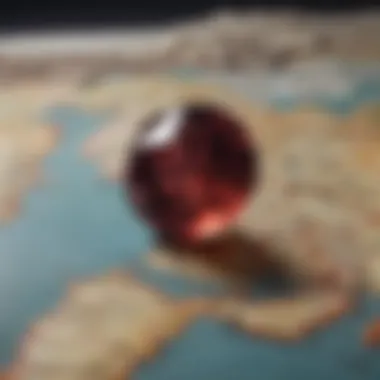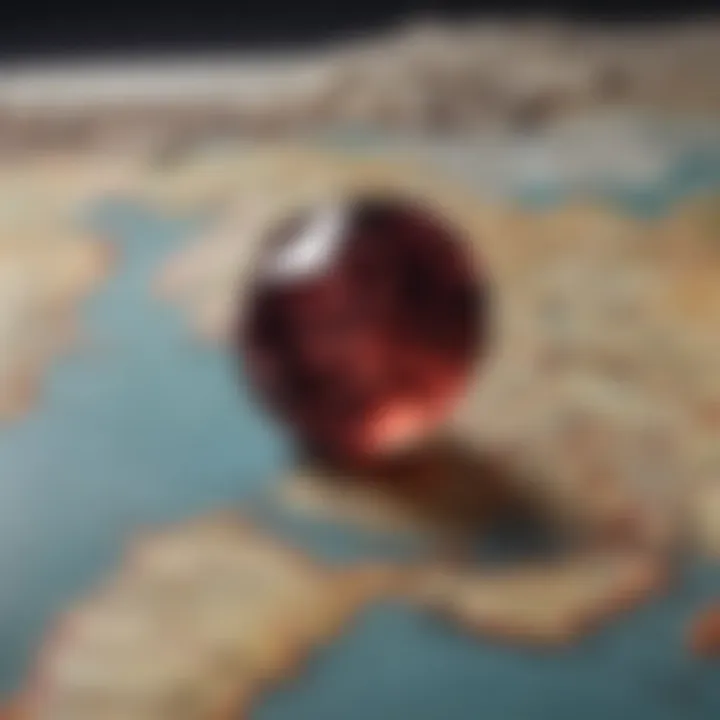A Journey Through the Most Rare Gemstones


Intro
The allure of gemstones has captured the imagination of humans for centuries. Those shimmering treasures of nature can invoke feelings of wonder, passion, and even reverence. It’s not just their aesthetic appeal that draws people in, but also the stories behind them. Rare stones, in particular, often come with a fascinating blend of beauty and history, making them objects of desire not only for collectors but also for scientists and jewelers alike.
This article seeks to explore the world of rare gemstones, going beyond the conventional understanding. With a blend of their unique characteristics, cultural significance, and economic value, we aim to equip both enthusiasts and professionals with a thorough understanding of these extraordinary minerals.
From the vibrant blue of Paraiba tourmaline to the vivid orange of fire opal, each stone has its own tale to tell. We will examine their origins and the geological and environmental conditions that make their existence truly remarkable.
As we peel back the layers, readers will discover an insight that extends beyond mere collection and curation, delving instead into the very fabric of why these stones are rare and precious.
"Gemstones are the poetry of the Earth, expressing its mysteries and beauty.”
Dive in as we navigate through the intricate landscape of rare stones, their stories, and their enduring appeal.
Prelude to Rare Stones
Rare stones, often referred to as gemstones, carry an air of mystery and fascination that captivates both hobbyists and experts. This section sets the stage for our exploration of some of the rarest gems found on our planet. By delving into the unique qualities and historical context of these stones, we uncover much more than just their market worth or aesthetic appeal. The stories behind each rare stone are rich in culture, geology, and the craft of gemstone design, making them invaluable not just as collectibles but also as pieces of Earth's history.
Understanding Rarity in Gemstones
Rarity in gemstones isn't merely about their scarcity; it encompasses a band of considerations that contribute to their allure. At its core, rarity is influenced by the stone's availability, geological formation, and demand in the market. Each gemstone has a tale that reflects a blend of nature's artistry and human imagination. The excitement of tracking down a rare gem speaks to the collectability and the quest for uniqueness.
- Availability: Some stones are found in specific locales under unique geological conditions, making them inherently scarce.
- Quality: The characteristics that set certain gemstones apart, such as color intensity, clarity, and size, often determine their rarity.
- Sustainability: Increasing concern about sourcing methods elevates the significance of rarity, as gemstones with ethical origins gain attention.
In understanding rarity, enthusiasts distinguish between common and rare gems—where the latter often tells a deeper story, one intertwined with nature’s whims and human endeavor.
Factors Contributing to Rarity
Several factors come into play when discussing the rarity of gemstones. These elements create a complex landscape that can affect their market value and desirability. Among them, some key factors include:
- Geological Conditions: Unique geological processes, such as volcanic activity or metamorphic transformations, lead to the formation of distinct gemstones. For instance, Tanzanite, found only in Tanzania, owes its status to the rare geological conditions under which it was formed.
- Market Demand: Trends and cultural preferences can suddenly elevate a gemstone’s rarity. When consumers begin to desire particular rare stones—think of the recent surge in demand for Morganite—equilibrium shifts, pushing prices higher.
- Natural Properties: Some stones like Alexandrite, known for their color-changing ability, are rare because of the specific conditions required for their formation. When nature gets creative, the result can be a spectacularly elusive stone.
- Mining Practices: Not all gemstones can be mined feasibly. The difficulty or danger associated with acquiring some rare gems—such as Painite—adds a layer to their rarity.
It's crucial for collectors and enthusiasts to grasp these aspects, as they provide insight into the evolving marketplace surrounding rare stones. As we progress through the article, we will illuminate these factors within the context of specific gemstones, expanding on their individual stories and significance.
Tanzanite: The Blue Wonder
Tanzanite holds a special place among the rare gems, not simply due to its striking cobalt blue hue but also because of its geographical exclusivity and the wonder surrounding its discovery. This stone, hailed as a modern classic, has piqued the interest of gemstone collectors and jewelry designers alike. It is the kind of stone that can turn heads—its vibrancy is captivating, and its rarity adds a layer of allure that is simply unparalleled.
The remarkable thing about tanzanite is not just its beauty but its very existence. Found exclusively in Tanzania, near Mount Kilimanjaro, this gem is a product of unique geological processes. The fascination with tanzanite lies in the fact that only a small region on Earth can produce it. Thus, every piece carries a story of the land it comes from. For gemstone enthusiasts and collectors, owning tanzanite is akin to holding a piece of geological history in their hands. In today's market, its value is influenced by these factors—its origins, beauty, and rarity aligning to create a coveted item for any serious collector.
Geological Origins of Tanzanite
Tanzanite's geological story starts in the East African Rift Valley—a locale known for its volcanic activity and unique mineral formations. This gem was first discovered in 1967 by a Maasai tribesman named Ali Juuyawatu. He stumbled upon the shimmering blue stones during his explorations. After the initial discovery, they quickly caught the attention of gemologists and miners. What makes its origin so unique is that the circumstances under which tanzanite forms—a combination of heat, pressure, and a specific composition of minerals—result in its rich color and characteristics.
The stone is a variety of zoisite and is formed when heat and pressure have transformed the host rock over millions of years. Its delicate balance of vanadium and titanium gives it the vivid blue hue that everyone admires. What’s astonishing is that the conditions that created this stone are incredibly rare. In fact, several geologists believe that tanzanite may eventually run out, making it all the more valuable as time passes.
Unique Color Properties
The color of tanzanite is one of its defining features. Depending on how the stone is viewed, it can shift between a royal blue and a purplish hue, thanks to a phenomenon known as pleochroism. This unique optical property allows tanzanite to display different colors when viewed from different angles, providing a varied visual experience that is captivating to many.
This color change seen in tanzanite is often a result of its composition as well. The presence of trace elements like vanadium plays a crucial role in its color development. When comparing tanzanite to other blue gemstones, such as sapphires, tanzanite’s unique characteristics shine through. While sapphires maintain their color uniformly, tanzanite’s shifting hues deliver an impression of depth, offering a multidimensional quality that few gemstones can match.
"Tanzanite is not simply a gemstone; it’s a living tapestry of Earth’s history, one that continues to unfold with each glance."
Many jewelers will cut tanzanite to enhance its unique hues, often favoring shapes that amplify its color brilliance. Whether set in a ring, necklace, or pair of earrings, the allure of tanzanite is undeniable—it’s a gem that speaks to the heart and tells a story beyond mere beauty. It captivates not only through its aesthetic appeal but also through the mystique of its rarity and geological significance.
Alexandrite: The Color-Changer
Alexandrite captures the imagination like few other gemstones. Renowned for its remarkable ability to shift hues, this stone attracts gem enthusiasts and collectors worldwide. Its origins, mystical allure, and value make it a significant topic of study in the world of rare stones. Understanding Alexandrite helps illuminate not only the beauty of this gem but also its historical context and the intricate processes that form its striking color characteristics.


Historical Significance of Alexandrite
Discovered in the Ural Mountains of Russia during the early 19th century, Alexandrite was named after Tsar Alexander II. The gem quickly gained popularity, partially because of its fascinating ability to change color; appearing green in daylight and shifting to red under incandescent light. This unique quality made it a symbol of the shifting fortunes of Russia at the time, marking it as a national treasure.
"Alexandrite's discovery coincided with a pivotal moment in Russian history, intertwining its fate with the empire's own turbulent narrative."
As the years rolled by, the gem found its way into royal collections and became a sought-after piece among aristocrats. Its rarity was further established as mining operations in the Ural Mountains dwindled, leading to Alexandrite being considered an extravagant luxury. Different sources emerged in the late 20th century, including deposits found in Brazil and Madagascar, albeit with varying color qualities, which sparked interest among enthusiasts and investors alike. The historical significance of Alexandrite isn’t just a tale of beauty; it’s a marker of time, culture, and the ever-evolving nature of gemstones presented throughout years.
Mechanics of Color Change
The color-changing feature of Alexandrite is not simply a gimmick, but rather a beautiful display of complex chemistry. Alexandrite contains traces of chromium which is crucial in creating its spectacular color shift. The stone exhibits pleochroism, meaning it displays different colors when viewed from different angles. This phenomenon is primarily due to the crystal structure and how the light interacts with it.
When viewed in natural daylight, Alexandrite often appears greenish to bluish-green due to the presence of strong blue and yellow light. Meanwhile, incandescent light alters this balance, revealing the rich reddish-purple tones. Such transformations have been captured by those who desire to understand the gem’s unique qualities and have a fascination with its complexity.
Alexandrite's characteristics can be summed up in a few key points:
- Color Variability: Displays green and blue hues in sunlight, and red in incandescent light.
- Pleochroic Nature: Shows different colors depending on the perspective and angle of light.
- Chromium Content: Essential for the color changes, providing depth to its visual enchantment.
Musgravite: The Hidden Gem
Musgravite is often overshadowed by its more famous counterparts in the world of rare gemstones. However, under the radar, it holds both historical significance and allure that captivates both gem enthusiasts and collectors. Discovered in the late 20th century, this exceptional stone not only showcases unique beauty but also demonstrates the life cycle of rare minerals that occur in specific geological settings. In this section, we will explore the fascinating journey of Musgravite, from its initial discovery to the complexities of identifying genuine specimens and understanding their market value.
Discovery and Identification
Musgravite was first found in the early 1960s in an area called the Musgrave Range, which is located in South Australia. This remote location holds its secrets closely, with the gem emerging only after extensive geological exploration. Its initial identification as a member of the beryllium family came with the recognition of its striking appearance and hardness. Unlike some gemstones, Musgravite can be quite challenging to identify due to its close resemblance to the more common beryl and spinel.
The identification process often involves advanced techniques. Gemologists will generally lean on inclusions and absorption spectra for a clearer distinction. A notable feature of Musgravite is its unique color range, which can vary from grayish to purplish hues, resembling the twilight sky. This color diversity makes it an attractive but elusive catch for gem collectors. Finding real Musgravite is akin to searching for a needle in a haystack, with only a handful of reputable sources available.
Market Demand and Valuation
The demand for Musgravite, while not as widespread as for more popular stones, has been gradually increasing. This rise can be attributed to its rarity and the prestigious status it has gained among gem collectors. Another factor is its compelling aesthetic qualities, making it an appealing option for bespoke jewelry pieces. Musgravite’s unique colors entice those willing to invest in something that is not just beautiful but also a conversation starter.
The valuation of Musgravite is decidedly complex. Factors influencing its price include carat weight, color saturation, and clarity. A well-cut stone with vivid purple or blue undertones can fetch significantly higher prices than those with muted colors.
"As the market for rare gemstones expands, Musgravite's value might see positive changes; investing early might lead to beneficial returns."
Collectibility often hinges on provenance and the stone's history, providing an additional layer of intrigue for potential buyers. Gem aficionados dive into this world, uncovering stories behind every stone, which only increases its overall value.
In summary, Musgravite serves as more than just a gemstone; it is a tale of discovery, rarity, and evolving market dynamics. Understanding this hidden gem involves delving into its history and appreciation within the gemstone community.
Painite: The Rarest of Them All
Painite truly holds a special place within the pantheon of rare gemstones. Not only is it statistically rare, but its peculiar attributes and rich history only amplify its mystique and desirability. For gemstone enthusiasts and collectors alike, understanding Painite is essential, as it offers insights into the geological processes that create such rare treasures. Moreover, its significance extends beyond mere aesthetics, leading into conservation efforts and ethical sourcing of gems that define the future of this niche market.
Geochemical Composition
Painite is primarily composed of boron, zirconium, calcium, and various trace elements, which contribute to its distinctive hue that can range from reddish-brown to a deeper dark shade. Its mineral formula, often represented as CaZr(B,Al)6O15, highlights the uniqueness of this stone. This complex geochemical structure is not just for show; it dictates how Painite interacts with light, influencing its optical properties. The rare occurrence of boron in its composition is noteworthy, as boron is a critical yet often scarce element in most minerals.
The crystalline structure of Painite allows it to refract light in captivating ways, creating a shimmering effect that draws attention. When viewed under different lighting conditions, Painite can glow with a vibrant luster, shifting color and making each specimen a unique work of art. Explorations have shown that when Painite is cut and polished well, it displays a depth and brilliance that is hard to match, even by more common gemstones.
Historical Context and Collectibility
The discovery of Painite is a fascinating tale that is steeped in history. Initially found in Myanmar (Burma) in the 1950s by gemologist Arthur Charles Dancy, it remained largely overlooked for decades, with only a handful of identified specimens attributed to this rare stone. Its first official recognition as a distinct mineral didn't come until the 1970s, leading to a revival of interest among gem collectors and geologists.
As for collectibility, Painite's rarity has positioned it among the elite gemstones for discerning collectors. With only a few known deposits in the world, mainly in Myanmar and more recently in Madagascar, the value of Painite has skyrocketed. In fact, prices can soar to tens of thousands of dollars per carat depending on quality and clarity. Collectors see Painite not just as a gem, but as a piece of natural history that tells a geological tale.
"Owning a piece of Painite is akin to possessing a fragment of the earth’s rarest secrets."
Interest in Painite is not solely driven by its market value; it’s also about the story it embodies. Each mineral carries a sense of history and preciousness that appeals to both collectors and jewelers. The knowledge of its rarity encourages a passion for conservation and ethical sourcing practices, ensuring that future generations can admire these stunning gems. Painite serves as a reminder of how nature crafts wonders beneath our feet, waiting for the right moment to be discovered.


Red Beryl: A Scarlet Treasure
Red Beryl, often overshadowed by its more famous cousins like ruby, has its own unique charm that stands out in the realm of gemstones. This scarlet treasure is not just a visual delight; it holds significant geological and economic importance as well. Rarely found in nature, its captivating hue and intricate formation processes make it a subject of intrigue for enthusiasts, collectors, and professionals alike.
When discussing rare gemstones, Red Beryl serves as a perfect illustration of how geological conditions can give rise to beauties that are both mesmerizing and scarce. The vibrant red tones of this stone result from trace amounts of manganese, setting it apart from other red stones that rely on chromium for color. For those who appreciate the art of jewel crafting, understanding Red Beryl’s properties and the challenges surrounding its sourcing is essential to appreciate its full value.
Formation of Red Beryl
Red Beryl is a beryllium aluminum silicate mineral that undergoes a series of intricate processes to reach its final form. Found predominantly in volcanic environments, it crystallizes from hydrothermal solutions. The specific conditions that favor its formation are rare, often limited to only a few locations around the globe, most notably in Utah, USA. This geographical limitation heavily influences its supply and, consequently, its market value.
When it comes to the formation specifics, the following points are vital:
- Temperature: Red Beryl forms at elevated thermal conditions that can stymie the crystallization of other minerals.
- Pressure: A balance of just the right amount can promote the successful growth of Red Beryl crystals, whereas too much can interrupt the process.
- Presence of Manganese: The unique color of Red Beryl is attributed to the incorporation of manganese ions, making its development somewhat inconsistent and challenging.
The rarity of these specific conditions results in extraordinarily few deposits of this stunning stone, hence its precious nature.
Challenges in Sourcing
Sourcing Red Beryl is often fraught with challenges, making it even more desirable for collectors. The locations where it is found are typically remote, demanding specialized mining techniques and significant effort to extract.
These challenges include:
- Limited Deposits: The known deposits of Red Beryl are few and concentrated, primarily in the Wah Wah Mountains of Utah.
- Mining Difficulties: The region includes rugged terrain that complicates extraction, risking both miner safety and yield efficiency.
- Ethical and Environmental Considerations: As with many rare gemstones, there are ethical concerns regarding mining practices. Responsible sourcing is essential to ensure the sustainability of Red Beryl while protecting the surrounding environment.
Amid these challenges, it is worth noting how the scarcity of Red Beryl can drive up its value even further, attracting attention from investors and connoisseurs alike.
"Red Beryl exists at the intersection of beauty and rarity, making it a true collectable treasure."
In summary, Red Beryl is not just a stone; it is a story of geological marvels and human endeavor. From its rare formation conditions to the challenges of sourcing it responsibly, this red gemstone truly represents a treasure worth knowing.
Benitoite: California’s Blue Gem
Benitoite, a gemstone that exudes a captivating allure, holds a pivotal place in our exploration of rare stones. This striking blue mineral, predominantly discovered in California, is not merely a feast for the eyes but also a significant component in the landscape of gemology. With its unique geological origins and challenges associated with its cutting and polishing, Benitoite offers a rich narrative that resonates with both gemstone enthusiasts and collectors alike.
Geological Uniqueness
The geological formation of Benitoite is one of its most fascinating aspects. Discovered in 1907 near Coalinga, California, Benitoite is a barium titanium silicate mineral. It was found in a specific geological setting — within metamorphic rocks that underwent high-pressure and low-temperature conditions. This is relatively rare, contributing to its scarcity. The interlocking layers of the rock matrix form a cradle for the beautiful blue crystals that are characteristic of Benitoite. This fascinating formation process requires precise environmental conditions, making it essential to understand the unique climate and geological history of California.
From a collector’s standpoint, Benitoite is notable not only for its beauty but also for its limited geographical availability. It's essentially known as California's state gem, a title that emphasizes its cultural significance in addition to its scientific merits.
- Distinctive Color: Its vibrant blue hue, which can show different shades depending on the light, adds to its appeal. While other gemstones can appear blue, Benitoite is uniquely distinguished by its crystalline form that emits a kind of shimmering quality.
This gemstone could often be mistaken for a more common blue sapphire, yet its unique features ensure that it stands alone in the gem world. Its geological importance is underscored by its rarity, as only a small number of deposits exist globally. New discoveries are rare, making Benitoite a coveted piece for any serious collection.
Cutting and Polishing Challenges
Cutting and polishing Benitoite demands an exceptional level of skill and care, setting it apart from many other gemstones. Given its relative softness compared to diamonds and sapphires, which are routinely cut in intricate designs, Benitoite requires specialized techniques. Missteps in this process can easily lead to cracks or chips, making successful lapidary work both a treasure and a challenge.
- Sensitivity to Pressure: The mineral's reaction to pressure during cutting means that the lapidaries must approach each piece with a delicate touch. Special equipment may be necessary to ensure the integrity of the gemstone remains intact.
- Preserving Color: During the polishing phase, there’s also the difficulty of maintaining the vivid color that distinguishes Benitoite. Lapidaries must choose suitable polishing compounds to avoid dulling the stone's vibrant hues.
The distinct challenges associated with cutting and polishing Benitoite highlight the importance of craftsmanship in theRare Gemstone community. Collectors particularly value pieces that are well-cut, not only because of aesthetic appeal but also due to the skill involved in creating such a delicate treasure.
“Benitoite is not just a gem; it is a story of the earth’s history, wrapped in a brilliant blue.”
In summary, Benitoite stands as a testament to the beauty and complexity of rare gemstones. Its geological uniqueness coupled with the artistry required in its processing showcases the nuances that make the world of gemstones so endlessly fascinating. This California gem offers both rarity and a rich narrative, making it a prized possession for anyone in the gemology field.
Black Opal: The Dark Beauty
Black opal, often regarded as one of the most stunning gemstones, captivates not only with its exceptional play of color but also with its depth and richness. This gemstone, primarily found in Australia, provides an interesting narrative in the realm of rare stones. The allure of black opal lies in its unique ability to reflect a spectrum of colors, often against a dark backdrop that enhances the brilliance of its hues. This section delves into the formation and characteristics of black opal, and how various factors influence its valuation among collectors and gem enthusiasts.


Formation and Characteristics
Black opal forms over millions of years within sedimentary rock, and it's primarily composed of silica spheres arranged in a lattice structure. The striking play-of-color that many admire comes from the interference of light within these spheres. The darker body tone of black opal, which ranges from deep black to dark gray, creates a stunning contrast to the vibrant spectral colors that emerge.
- Colors: Black opal displays a range of colors, including reds, blues, greens, and purples. The intensity and diversity of these colors can vary significantly depending on the specific deposits from which they are mined.
- Clarity: Similar to other gemstones, clarity plays a role in its value. Black opals can contain inclusions, but stones with fewer blemishes tend to be more sought after.
- Cut: The way black opal is cut can also affect its appearance. Common cuts include cabochon, which enhances the gem’s color display, making it more visually appealing.
The geological conditions required for the formation of black opal are quite rare, involving a specific combination of temperature, pressure, and the presence of certain minerals. It's believed that these remarkable stones were formed in the remains of ancient lakes, where silica-rich waters precipitated and filled voids in the substrate.
Valuation Factors in Black Opal
Valuing black opal is not merely a straightforward exercise; several intricate elements come into play that can dramatically influence a stone's market worth.
"The value of black opal hinges on its unique interplay of color, clarity, and cut—resulting in a gem that commands attention and admiration."
- Origin: The most prized black opals come from Lightning Ridge in Australia, which is known for producing a rich variety of opals with exceptional color play. Other sources, like Coober Pedy and Andamooka, also yield black opals but they don’t typically possess the same level of quality.
- Color and Pattern: More vibrant colors and intricate patterns significantly increase the value of black opals. Stones with a nice broad flash or those that exhibit multiple colors, known as “harlequin” patterns, are especially desirable.
- Certification: Provenance and certification from recognized gemological laboratories can add to the stone's credibility and thus its value. This is crucial in the current market, as collectors are increasingly aware of the importance of authenticity.
- Market Demand: Like any rare collectible, the demand plays a vital role in valuation. With the growing interest in unique gemstones, there is a spotlight on black opals, leading to increased prices and investment potential.
In summary, black opal is much more than just a beautiful stone; its fascinating formation process contributes to its rarity, while unique factors govern its market value. As collectors continue to seek out this dark beauty, understanding these elements allows for a deeper appreciation of one of nature's most exquisite creations.
Grandidierite: The Elusive Spotlight
Grandidierite stands out as one of the rarest gemstones in the world, a treasure that is as captivating as it is elusive. Its discovery is intrinsically tied to the Malagasy landscape, where the mineral is predominantly mined. While many gem enthusiasts may find themselves drawn to the vivid colors of more renowned stones, Grandidierite deserves its moment in the spotlight. It showcases not only a remarkable blend of aesthetics but also an intriguing geological narrative that underscores both its rarity and unique beauty.
Many gem lovers might be unaware that Grandidierite is predominantly found in Madagascar—the very place it was originally named after the French explorer Alfred Grandidier. Unlike your common gemstones that can be found in abundance, this one is like trying to find a needle in a haystack. Its translucent blue-green hue, combined with its pleochroism, offers a breathtaking visual appeal, making it a desirable piece in any serious collection.
Geographical Distribution
Grandidierite is a true product of its environment. While Madagascar is the primary source, small deposits have been discovered in other locations, such as Sri Lanka. However, these findings are nowhere near the quantities located in Madagascar.
The geological conditions that give rise to Grandidierite are rare. The mineral forms under high temperatures and pressures, often alongside other minerals like cordierite and forsterite. The remote mining locations in Madagascar add another layer to its mystique; many of these sites are hard to access, making extraction quite a challenge. The regions where Grandidierite is found are not just geological wonderlands but also steeped in cultural and social narratives, adding depth to this elusive gem.
"Grandidierite's rarity reflects the unique geological conditions found exclusively in certain parts of Madagascar."
Market Trends and Investment Potential
Now, let’s talk numbers. The market for Grandidierite is on a slow but steady rise, largely due to its rarity and emerging status among collectors. In contrast to other more established gems, the Grandidierite market is less saturated, which can mean less volatility. Over the last few years, gemstone investors and collectors are increasingly recognizing the value of rare minerals, and Grandidierite is no exception.
Investing in rare stones like Grandidierite can offer substantial returns—not just because of potential price increases, but also due to their uniqueness. As more collectors become aware of its distinct characteristics, demand may rise, allowing prices to reflect this newfound interest.
- Scarcity: Given its limited geographical footprint, Grandidierite is facing the unique challenge of supply not being able to catch up with increasing demand.
- Collectability: The allure of having a stone that few can claim to own adds to its value.
- Market Education: With increasing information dissemination on platforms like Reddit and specialist gem sites, awareness is growing.
The potential for Grandidierite to become a mainstay in investment portfolios seems promising. As we move into a future that prioritizes unique and rare items, this gemstone is well-positioned to capture both the heart and the wallet of gem aficionados.
The End: The Allure of Rare Stones
In the grand tapestry of Earth's natural treasures, rare gemstones play a unique and fascinating role. Their allure lies not only in their stunning aesthetics but also in their stories, origins, and the threads of human history interwoven with them. As we draw this exploration of rare stones to a close, it's pertinent to reflect on why these gemstones are significant—not just for collectors and enthusiasts, but for the broader spectrum of society.
Rare stones like tanzanite, alexandrite, and painite captivate the imagination. Each gem carries its own tale; a narrative shaped by geological wonders and human endeavor. This article has unpacked the complexities of these stones—from their formation in the bowels of the Earth to their shimmering presence in our jewelry boxes. Such stones are symbols of rarity, beauty, and sometimes even status, transcending mere decoration to become items of profound significance.
The contemporary fascination with rare gemstones is fueled by their investment potential. The fluctuating demands in market spaces create new opportunities for savvy collectors. Investing in rare stones not only promises potential monetary gain but also fosters a connection to Earth's depths and regional histories.
Yet, with this allure comes the responsibility to approach gem collecting thoughtfully and ethically. The market for rare gemstones can sometimes be murky, with questionable sourcing practices casting a dark shadow over their beauty.
Future of Rare Gemstones
As we gaze into the future of rare gemstones, we recognize a dynamic landscape forming. Consumer preferences are shifting, leaning towards stones that offer both beauty and ethical sourcing. Manufacturers and jewelers respond to this trend by prioritizing transparency, which is crucial for maintaining the beauty of the gemstone industry. Furthermore, technological advances in sourcing and identifying these stones may impact their market availability.
Stone enthusiasts should keep an eye on growing sectors like synthetic diamonds and lab-created variants, which are pressing to blend the line between rarity and accessibility. The growing appreciation for unique and eco-friendly alternatives could reshape how we perceive value in gemstones.
Call for Conservation and Ethical Sourcing
The beauty of these rare stones beckons for a conscientious approach to collecting and utilization. Conservation is not merely an environmental issue but a moral one, demanding that gem enthusiasts advocate for sustainable practices. The story of a gemstone does not end at its purchase; it expands into how those stones interact with the communities from which they originate.
By emphasizing ethical sourcing, collectors can ensure that their passion does not come at the expense of exploitation or environmental degradation. It’s imperative to champion systems that prioritize the welfare of local miners, fair wages, and continued environmental stewardship. Therefore, forging strong links with ethical suppliers and organizations can help bend the curve towards responsible gem collecting. Solidifying this commitment not only enriches one’s collection but also forges a legacy that appreciates and protects the earth's treasures.
In summation, the allure of rare stones holds a mirror to our world—a blend of beauty, intrigue, and moral responsibility. It prompts us to consider how our choices today will shape the gemstones of tomorrow. Collecting is not just about adornment; it is a statement, an investment, and a chance to leave a positive mark on the universe.







